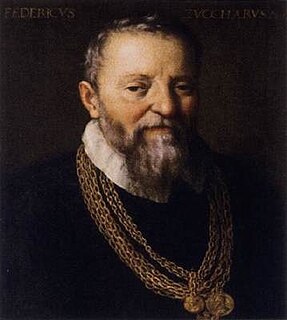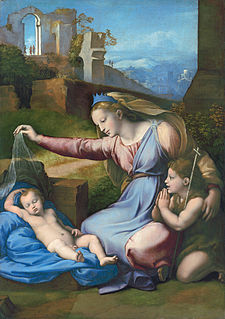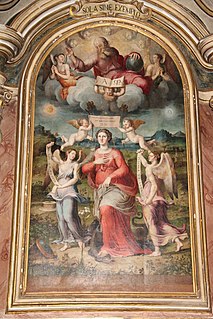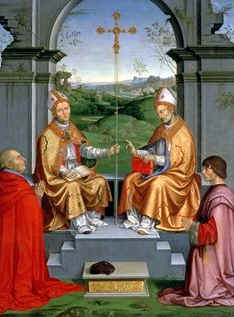Related Research Articles

Federico Zuccaro, also known as Federico Zuccari, was an Italian Mannerist painter and architect, active both in Italy and abroad.

Giorgio Vasari was an Italian painter, architect, engineer, writer, and historian, best known for his Lives of the Most Excellent Painters, Sculptors, and Architects, considered the ideological foundation of art-historical writing, and the basis for biographies of several Renaissance artists, including Leonardo da Vinci and Michelangelo. Vasari designed the Tomb of Michelangelo in the Basilica of Santa Croce, Florence that was completed in 1578. Based on Vasari's text in print about Giotto's new manner of painting as a rinascita (rebirth), author Jules Michelet in his Histoire de France (1835) suggested adoption of Vasari's concept, using the term Renaissance to distinguish the cultural change. The term was adopted thereafter in historiography and still is in use today.

Giulio Romano, also known by his real name of Giulio Pippi, was an Italian painter and architect. He was a pupil of Raphael, and his stylistic deviations from High Renaissance classicism help define the 16th-century style known as Mannerism. Giulio's drawings have long been treasured by collectors; contemporary prints of them engraved by Marcantonio Raimondi were a significant contribution to the spread of 16th-century Italian style throughout Europe.

Pesaro is a city and comune in the Italian region of Marche, capital of the Province of Pesaro e Urbino, on the Adriatic Sea. According to the 2011 census, its population was 95,011, making it the second most populous city in the Marche, after Ancona. Pesaro was dubbed the "Cycling City" by the Italian environmentalist association Legambiente in recognition of its extensive network of bicycle paths and promotion of cycling. It is also known as "City of Music" for it is the birthplace of the composer Gioacchino Rossini. In 2015 the Italian Government applied for Pesaro to be declared a "Creative City" in UNESCO's World Heritage Sites. In 2017 Pesaro received the European City of Sport award together with Aosta, Cagliari and Vicenza.

Gianfrancesco Penni (1488/1496–1528), also known as Giovan Francesco, was an Italian painter. His brother Bartolommeo was an artist of the Tudor court of Henry VIII, and another brother, Luca, ended up as one of the Italian artists of the School of Fontainebleau.

Girolamo Genga was an Italian painter and architect of the late Renaissance, Mannerist style.

Stradanus, Johannes Stradanus, Jan van der Straet or Giovanni Stradano was a Flemish artist active mainly in 16th-century Florence, Italy. He was a wide-ranging talent who worked as an easel and fresco painter, designer of tapestries, draughtsman, designer of prints and pottery decorator. His subject range was varied and included history subjects, mythological scenes, allegories, landscapes, genre scenes, portraits, architectural scenes and animals. After training in his native Flanders, he left his home country and ultimately settled down in Florence, Italy. He became a prominent court artist to the Medici during the second half of the 16th century and worked on the many decorative projects of the court. Stradanus also produced large altarpieces for the most important churches in Florence.

Raffaellino del Colle (1490–1566) was an Italian Mannerist painter active mostly in Umbria. He was born in the frazione of Colle in Borgo Sansepolcro, province of Arezzo, Tuscany, Italy.

Francesco de' Rossi was an Italian Mannerist painter who lived and worked mainly in Florence, but also produced several works in Rome. He is known by many names, prominently the adopted name Francesco Salviati or as Il Salviati, but also Francesco Rossi and Cecchino del Salviati.
Events from the year 1574 in art.

Battista Franco Veneziano also known by his correct name of Giovanni Battista Franco was an Italian Mannerist painter and printmaker in etching active in Rome, Urbino, and Venice in the mid 16th century. He is also known as il Semolei or just Battista Franco.

Francesco Menzocchi (1502–1574) was an Italian painter of the late-Renaissance and Mannerist period. He was born in Forlì, belonged to the Forlì painting school and was active mainly in Forlì and Pesaro.

Lorenzo Leonbruno, also known as Lorenzo de Leombeni, was an Italian painter during the early Renaissance period. He was born in Mantua (Mantova), an Italian commune in Lombardy, Italy. Leonbruno is most well known for being commissioned by the court of Francesco Gonzaga, Marquis of Mantua, and his wife Isabella d'Este. The patronage continued with their eldest son Federico II Gonzaga, who was the fifth Marquis of Mantua. Leonbruno was the court painter for the Gonzaga family from 1506–24.

Timoteo Viti, sometimes called Timoteo della Viti or Timoteo da Urbino, was an Italian Renaissance painter, who was closely associated with Raphael, who was fourteen years his junior.

The Palazzo Grimani of Santa Maria Formosa is a State museum, located in Venice in the Castello district, near Campo Santa Maria Formosa.
Rinaldo Mantovano, also called Domenico Rinaldo, was an Italian painter from Mantua who was active between 1527 and 1539. According to Giorgio Vasari he was the most talented assistant of Giulio Romano during his stay in the service of the Gonzaga Marquis' of Mantua.

Giovanni De Min was an Italian painter and engraver, active in a Neoclassic style.

The Villa Imperiale of Pesaro is a suburban palatial house outside of Pesaro, built and decorated by artists of the late-Renaissance or Mannerist period. It is now a private residence but the frescoed rooms and elaborate gardens are available for touring.

Giovanni Battista Crosato was an Italian painter of quadratura, active in the 18th century in Piedmont.

Daniel van den Dyck, known in Italy as Daniel Vandich was a Flemish painter, printmaker, architect and engineer. After training in Antwerp he left for Italy where he first worked in Venice and later became a court painter in Mantua. He was a versatile artist who created mythological and religious scenes, as well as portraits and flower-pieces.
References
- ↑ encyclopedia [ permanent dead link ], Dizionario Biografico degli Italiani, Volume 18 (1975) by EE. Safarik.
- ↑ Arte e Storia, Le Pittura del Palazzo Grimani, page 57-58.
- ↑ Treccani encyclopedia, (1975) by EE Safarik.